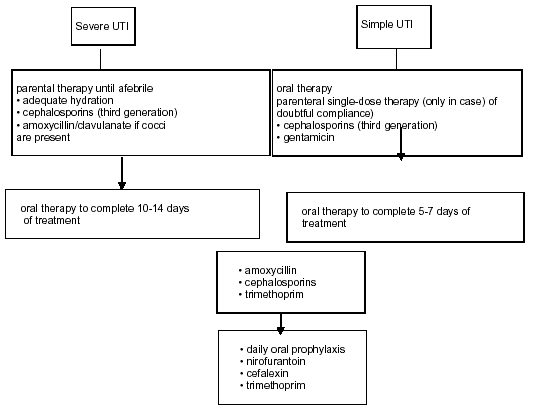A severe UTI requires adequate parenteral fluid replacement and appropriate antimicrobial treatment, preferably with cephalosporins (third generation). If a Gram-positive UTI is suspected by Gram stain, it is useful to administer aminoglycosides in combination with ampicillin or amoxicillin/clavulanate. Antimicrobial treatment has to be initiated on an empirical basis, but should be adjusted according to culture results as soon as possible. In patients with an allergy to cephalosporins, aztreonam or gentamicin may be used. When aminoglycosides are necessary, serum levels should be monitored for dose adjustment. Chloramphenicol, sulfonamides, tetracyclines, rifampicin, amphotericin B and quinolones should be avoided. The use of ceftriaxone must also be avoided due to its undesired side effect of jaundice. A wide variety of antimicrobials can be used in older children, with the exception of tetracyclines (because of teeth staining). Fluorinated quinolones may produce cartilage toxicity, but if necessary may be used as second-line therapy in the treatment of serious infections, since musculoskeletal adverse events are of moderate intensity and transient. For a safety period of 24-36 hours, parenteral therapy should be administered. When the child becomes afebrile and is able to take fluids, he/she may be given an oral agent to complete the 10-14 days of treatment, which may be continued on an outpatient basis. This provides some advantages, such as less psychological impact on the child and more comfort for the whole family. It is also less expensive, well tolerated and eventually prevents opportunistic infections. The preferred oral antimicrobials are: trimethoprim (TMP), co-trimoxazole (TMP plus sulphamethoxazole), an oral cephalosporin, or amoxicillin/clavulanate. However, the indication for TMP is declining in areas with increasing resistance. In children less than 3 years of age, who have difficulty taking oral medications, parenteral treatment for 7-10 days seems advisable, with similar results to those with oral treatment. If there are significant abnormalities in the urinary tract (e.g. vesicoureteral reflux, obstruction), appropriate urological intervention should be considered. If renal scarring is detected, the patient will need careful follow-up by a paediatrician in anticipation of sequelae such as hypertension, renal function impairment and recurrent UTI.
An overview of the treatment of febrile UTIs in children is given in Figure: Treatment of ebrile UTIs in Children and the dosing of antimicrobial agents is outlined in Table Dosing of Antimicrobial Agents in Children Aged 3 Months to 12 Years.
Figure. Treatment of Febrile UTIs in Children
Table. Dosing of Antimicrobial Agents in Children Aged 3 Months to 12 Years*
Antimicrobial agent
Application
Age
Total dosage per day
Doses per day
Ampicillin
Intravenous
3-12 months
100-300 mg/kg BW
3
Ampicillin
Intravenous
1-12 years
60-150 (-300) mg/kg BW
3
Amoxicillin
Oral
3 months to 12 years
50-100 mg/kg BW
2-3
Amoxicillin/clavulanate
Intravenous
3 months to 12 years
60-100 mg/kg BW
3
Amoxicillin/clavulanate
Oral
3 months to 12 years
37.5-75 mg/kg BW
2-3
Cephalexin Treatment
Oral
3 months to 12 years
50-100 mg/kg BW
3
Prophylaxis Cefaclor
Oral
1-12 years
10 mg/kg BW
1-2
• Treatment
Oral
3 months to 12 years
50-100 mg/kg BW
3
• Prophylaxis
Oral
1-12 years
10 mg/kg BW
1-2
Cefixime
Oral
3 months to 12 years
8-12 mg/kg BW
1-2
Cetriaxone
Intravenous
3 months to 12 years
50-100 mg/kg BW
1
Aztreonam
Intravenous
3 months to 12 years
(50)-100 mg/kg BW
3
Gentamicin
Intravenous
3-12 months
5-7.5 mg/kg BW
1-3
Gentamicin
Intravenous
1-2 years
5 mg/kg BW
1-3
Trimethoprim
• Treatment
Oral
1-12 years
6 mg/kg BW
2
• Prophylaxis
Oral
1-12 years
1-2 mg/kg BW
1
Nitrofurantoin
• Treatment
Oral
1-12 years
3-5 mg/kg BW
2
• Prophylaxis
Oral
1-12 years
1mg/kg BW
1-2
BW = body weight.

